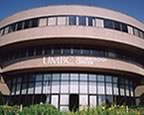|
||||||||||||||||||||||||||||||||||||
|
However, a surge in funding for homeland security and contract awards from the National Security Agency and the Department of Defense is fueling a comeback for some high-tech companies. While the evidence is largely anecdotal, the fact that high-tech companies have again begun to lease space at the campus is a sign that high-tech slump is over, according to Ellen Hemmerly, executive director of the research park. “Some tech companies are re-emerging,” said Hemmerly. One such company is St. Louis-based TechGuard Security LLC, which in May decided to move to the tech center because of its proximity to federal agencies and the Baltimore/Washington International Airport. “We also have access to the UMBC students and its research and development resources,” said TechGuard Director of Operations Johnny Flores. Being close to Washington is crucial for TechGuard because it is a certified disadvantaged business enterprise and an 8(a) certified, woman-owned small business. This means the company, which offers computer security services, can qualify for sole-source bids with federal agencies and special contracts set aside for firms deemed disadvantaged. On the other hand, AVIcode Inc., which relocated to the park earlier this week from Connecticut, markets its integration services primarily to the private sector. “We expect to do business with the government, but now our customers are companies like Microsoft Corp.,” explained AVIcode President and Chief Executive Michael Curreri. But the increased business at specialized centers like the UMBC Research Park and the national security-focused Chesapeake Technology Center in Anne Arundel County is not necessarily shared in the wider economy. Gerard Wit, vice president of Catonsville-based commercial developer MIE Properties Inc., has not seen a similar surge in high-tech firms leasing space from his company. “I don't see it as a growing trend,” he said. Wit also believes that UMBC's development of the park is moving at a much slower pace than it would if a private company were in charge. “With all the bureaucracy and committees they have to go through for approval, we can build four projects in the time it takes them to build one,” said Wit. Nonetheless, UMBC's Hemmerly is optimistic about the future build-out of the park, which will include five buildings and 330,000 square feet of space when completed. “The hope is with the current momentum it will happen within three to four years,” said Hemmerly. In mid-August the second of five buildings will be completed and 60,000 square feet of new space will be made available to high-tech firms. While she declined to identify them, Hemmerly said at least two more high-tech companies were close to an agreement with UMBC. Although the migration of high-tech companies to the campus is a positive sign, recent national surveys appear to show that the high-tech recovery in the Baltimore-Washington area could be ahead of the national curve. For example, when chief information officers were recently interviewed for the Robert Half Information Technology Hiring Index and Skills Report, a report compiled by the national job placement company, they were cautious about their third-quarter hiring. Eight percent of the executives said they expected to add IT staff, while 3 percent planned personnel cutbacks. The net 5 percent hiring increase compares with a net 9 percent increase forecasted last quarter, when results hit their highest level in two years. Meanwhile, 88 percent of the executives said they planned to simply maintain existing levels of staff. Moreover, a 179 percent surge in planned job cuts announced in the second quarter by computer firms is a reminder that many high-tech jobs are still being eliminated at the same time new jobs are created, according to a July report from outplacement firm Challenger, Gray & Christmas Inc. |
|||||||||||||||||||||||||||||||||||
|
bwtech@UMBC Incubator and Accelerator• 1450 South Rolling Road • Baltimore, MD 21227 410.455.5900 • 410.455.5901 fax • techcenter@umbc.edu |
||||||||||||||||||||||||||||||||||||




